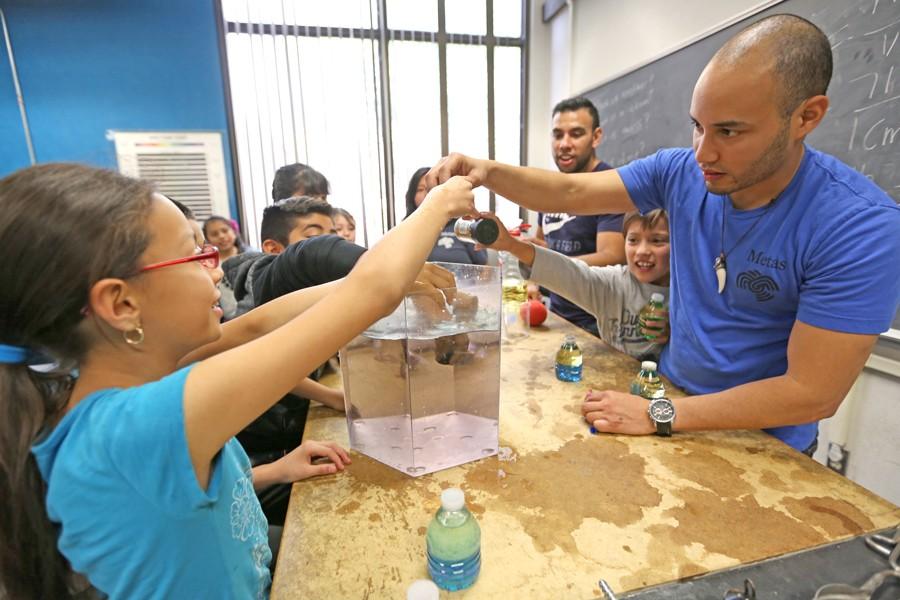Program highlights realistic scientific usages
STEM Day shows potential career paths, skills
ABOVE: Society of Hispanic Professional Engineers Vice President Christian Talavera educates K-12 students during the STEM Day in the PS-113 on March 21.
Apr 7, 2015
Science Technology Engineering Math (STEM) Day gave K-12 students a glimpse into the hands-on lab work that the STEM program at Contra Costa College provides through interactive workshops on March 21 from 11 a.m. to 3 p.m. campuswide.
“We are trying to show students that we need engineers and physicists to help keep up (scientific) progress. There are a lot of applications with (any of these) majors,” tutor and mechanical engineer major Alejandro Romero said.
Metas and Adelante programs assistant Walter Orellana said students from 54 K-12 schools, mostly within the West Contra Costa Unified School District (WCCUSD), participated in the event.
STEM Day workshops took place during what would normally be a tutoring day for the college students in the program.
STEM Grant and METAS Program Manager Mayra Padilla said besides being offered the opportunity to educate young minds about any one of the STEM disciplines, these college students where also given the chance to be able to view their tutors as leaders as they led the various workshops during STEM Day.
Orellana helped organized the workshops and locations of the event. He said the effort to put on the event is a reflection of the teamwork that comes out of the Hispanic Serving Institution (HSI) STEM Office.
The STEM student-led workshops allowed for the younger K-12 students to see what some of their daily schoolwork entails.
CCC alumnus Robin Lopez gave the keynote presentation in LA-100 and shared some of his life choices growing up in Richmond, California that led him toward a negative path. He said taking a chance at an education has been something that he has considered to be valuable.
“You can have the best plans,” he said, “but life can throw you hammers.”
Middle College High School student Marisol Contreras said she empathized with Lopez’s personal story and it made her feel she could pursue a science or math career.
Dr. Padilla said in previous years more speakers from different STEM professions attended the event and led the workshops, but this year that responsibility was left to current and former CCC students.
She said they invite working professionals to show the younger students that “it can be done.” Whatever their goal may be, it can be accomplished because there are others who are living proof.
Romero was in charge of the Electricity Magnetism workshop. Through his presentation he demonstrated the uses by having students physically experiment with the magnets.
“These (K-12 students) are being exposed to (different) science fields. They can see people studying and relate by having the opportunity to learn (STEM’s practical) applications,” mechanical engineering major Valeria Avila said.
Avila led one of the workshops, which explained the different states of matter to a group of students by using root beer floats as examples.
The transition into different states of matter, which are solids, liquids and gas, were each represented through the melting process that the ice cream goes through once the root beer is poured. A gaseous, but delicious effect resulted.
“This year’s STEM Day differed from last year in that we incorporated (CCC’s) very own rising scientist and engineers from CSE and SHPE,” she said.
In another workshop, biology major Brenda Vega and mechanical engineering major Kevin Hernandez experimented with chemicals such as methane and hydrogen to produce methane bubbles, which once lit on fire instantly vanished.
MCHS senior Noemi Corona said she learned new things during her experience at STEM Day that she wouldn’t have been given the chance to learn otherwise.
“Ocean in a Bottle” was one of the workshops mechanical engineering majors Christian Talavera and Evelio Perez led. Students learned about density and mass using a plastic bottle filled with water, food coloring, cooking oil and glitter as an example of how different liquids don’t mix.



